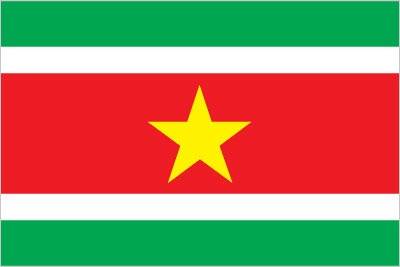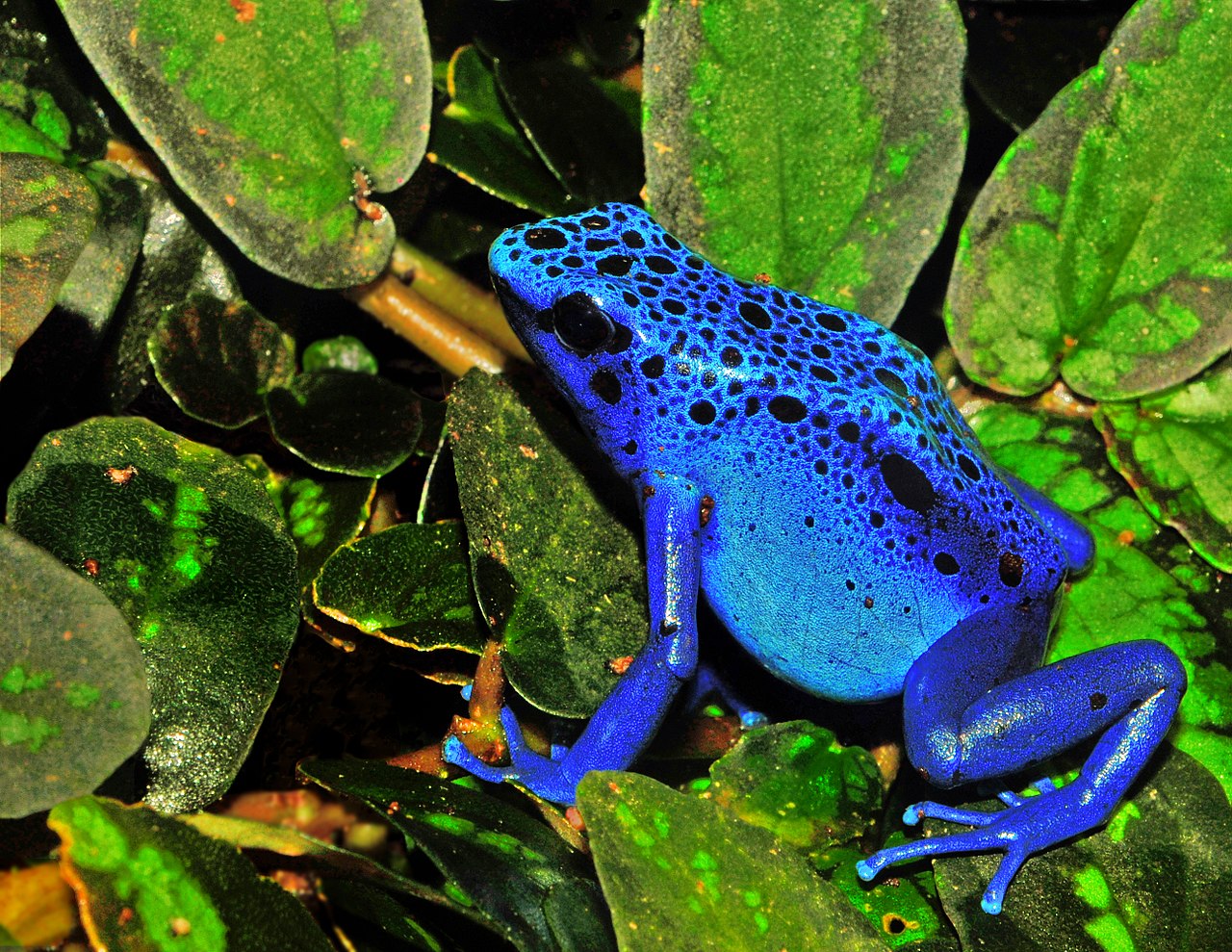33 Suriname

Five horizontal bands of green (top, double width), white, red (quadruple width), white, and green (double width). A large, yellow, five-pointed star is centered in the red band. Red stands for progress and love, green symbolizes hope and fertility, white signifies peace, justice, and freedom. The star represents the unity of all ethnic groups. From its yellow light the nation draws strength to bear sacrifices patiently while working toward a golden future.
Flag courtesy of the CIA World Factbook

Map courtesy of CIA World Factbook

The blue poison dart frog is endemic to Suriname.
Government
According to Britannica, under the 1987 constitution, legislative power is exercised by the popularly elected 51-member unicameral National Assembly, which in turn elects a president and vice president. The president, vice president, and members of the National Assembly serve five-year terms. The president is the chairman of a nonelective, military-influenced Council of State, which ensures that the government’s actions conform to the law. It has constitutional powers to annul laws passed by the National Assembly. The judicial system consists of a Court of Justice and cantonal courts. Suriname is a member of the Caribbean Court of Justice, the final court of appeal for Caribbean Community members.
Local government was established in Suriname in 1987. It is divided into distrikten (districts) and ressorten (subdistricts). Each district has a representative and an executive branch of government. The former are run by district raden (district councils), and the latter are administered by districtsbestuur (district administrations). At the subdistrict level there is only a representative branch managed by ressort raad (subdistrict councils). Both the district and subdistrict councils are elected every five years at the country’s general elections.
Civil Aviation Safety Authority Suriname (CASAS)
In 1996, a Safety Oversight assessment team of ICAO followed by an audit group of the FAA conducted safety oversight audits in Suriname to determine whether or not Suriname by means of legislation and other mechanisms fully complied with international and national regulations to guarantee aviation safety. Both teams came to the conclusion that the Surinamese Civil Aviation Act, which dated back to 1935 did not comply, was restricted and as such did not guarantee aviation safety. It was also concluded that the required organizational structure was missing whereas at the time, the much needed coordination between the several departments was impossible. As a result, the FAA decided to rate the Republic of Suriname in Category III, which means that with regard to aviation safety, the regulations did not meet international standards and no aircraft registered in Suriname was allowed to land within the territory of the United States of America. While taking into account the complexity of international civil aviation legislation and technological developments worldwide, this decision by the FAA with the full support of the ICAO necessitated a new construction to guarantee aviation safety at all times with the ultimate goal of regaining and sustaining Category I rating for Suriname. For this purpose the following actions had to be taken:
(1) Establish a well-structured organization initially in charge of flight operations, airworthiness and personnel licensing;
(2) Formulate a new civil aviation act adapted to new international standards;
(3) Formulate mechanisms to ensure aviation safety oversight at all times;
(4) Draw up regulations to meet the requirements set forth in the sector;
(5) Establish rules to enable the above-mentioned organization to regulate and take measures when necessary;
(6) Draw up regulations; in this case the Civil Aviation Regulations Suriname (CARS) were formulated.
Civil aviation characterizes itself that the ever developing technology compels states to continuously modify and amend regulations to comply with the Annexes to the Chicago Convention of 1944. In the end, the above-mentioned initially resulted in the founding of the Civil Aviation Safety Authority Suriname (CASAS) by State Decree of 12 May 1997 listing the duties and responsibilities of this body pending a new act on civil aviation. After the CASAS has been established, a draft civil aviation act was drawn up which would reflect the developments within international civil aviation in the past 15 years with the emphasis on safety and security of the sector for which reference can be made to articles 4 and 5 of the draft act. On 28 February 2002 the Act on Safety and Security of Civil Aviation in Suriname was approved by parliament and subsequently enacted on 12 March 2002.
Airspace
SkyVector – Google Maps – ADS-B Exchange
ICAO countries publish an Aeronautical Information Publication (AIP). This document is divided into three parts: General (GEN), En Route (ENR) and Aerodromes (AD). ENR 1.4 details the types of airspace classes they chose to adopt from classes A through G.
Drone Regulations
Decision Director CASAS – DDC.001 – OPS/AIR/AVSEC – Unmanned Aircraft
Advanced Air Mobility (AAM) Regulations & Policies
None found by the author.
However, should you, the reader, happen to stumble across something to the contrary, please email the author at FISHE5CA@erau.edu and you may be mentioned in the ACKNOWLEDGEMENTS section of this book by way of thanks for contributing to this free eBook!
Advanced Air Mobility (AAM) News
None found by the author.
However, should you, the reader, happen to stumble across something to the contrary, please email the author at FISHE5CA@erau.edu and you may be mentioned in the ACKNOWLEDGEMENTS section of this book by way of thanks for contributing to this free eBook!
Short Essay Questions
Scenario-Based Question
You have been hired by a Drone Startup Company. Your boss has immediately assigned this job to you.
They need you to prepare a one-page memo detailing the legalities of using a drone in Suriname.
They need you to mention any national laws and local ordinances.
They specifically want to know what airspace (insert pictures) you will be operating in and whether or not you need an airspace authorization.
Does it matter whether or not you are a citizen of the country?
Lastly, there is a bonus for you if, as you scroll through this chapter, you find any typos or broken links!
Short Essay Questions
- What are the drone categories?
- How is registration addressed?
- How is remote ID addressed?
- What are the model aircraft rules?
- What are the commercial drone rules?
- Are there waivers or exemptions to the rules? If so, for what?
- Would you share a link to an interactive airspace map?
- How is BVLOS addressed?
- How can you fly drones at night?
- How can you fly drones over people?
- Where do you find drone NOTAMs?
- What are the rules for drone maintenance?
- What are the rules for an SMS program?
- What are some unique rules not mentioned above?
- What are the C-UAS rules?
- What are the AAM rules?

